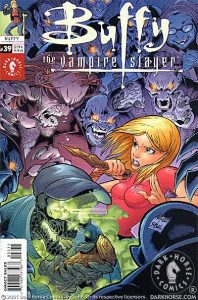Tom Fassbender and Jim Pascoe wrap up their run on “Buffy the Vampire Slayer Classic” with eight more issues that demonstrate their excellent knowledge of the TV show’s narrative and character arcs. They provide an emotional grace note to “The Body” (and Fabian Nicieza’s “Lost and Found” does the same for Buffy’s death) and give us the lead-up story to the resurrection of Buffy at the start of Season 6 — the most important “Buffy” spinoff fiction to date.
“Night of a Thousand Vampires” (Issue 39, November 2001)
Joyce’s death is something best left to TV’s “The Body” (5.16), something that the comic book couldn’t compete with. At the same time, it couldn’t skim over it. Issue 39, which finds the mother of the crazy chick whom Buffy defeats in Issue 28 out for revenge, wonderfully addresses this conundrum. Fassbender and Pascoe show how Willow and Xander feel helpless to alieve Buffy’s grief, then portray catharsis-through-violence as Buffy offs an insane number of vampires in six straight pages of panels filled with green mist (the comics’ way of showing vamps being dusted). It’s an “on steroids” answer to that great TV moment when she skewers three vampires in quick succession.
4.5 stars
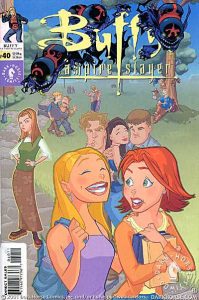
“Ugly Little Monsters” (Issues 40-42, December 2001-February 2002)
Editor Scott Allie wanted something lighter between the death of Joyce and the death of Buffy. This story featuring annoying football-sized bugs that pester the gang is also experimental, with every page featuring exactly three panels. Unfortunately, it’s not a memorable arc, and I didn’t quite follow the mystery of who summoned the beasties. But it’s a credit to the writers that I now take for granted that their characterizations of the gang are spot-on, and it ends with a nice foreshadowing of “The Gift” (5.22) when Spike tells Dawn: “Stop sneaking around, and do what you’re told. Your sister may not always be here to look after you.”
3 stars
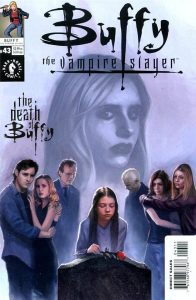
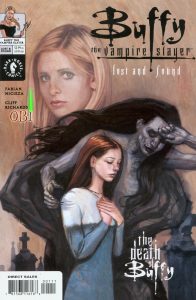
“The Death of Buffy” (“Lost and Found,” March 2002, and Issues 43-45, March-May 2002)
Dark Horse does its most important gap-filling to date with this arc set in the wake of Season 5. It starts with the one-shot “Lost and Found” by future main title scribe Nicieza. It’s a wonderful grace note to “The Gift,” using the narrative device of Dawn writing in her journal that also worked well on “False Memories” (35-38). Nicieza wisely uses a demon that feeds on grief as a way to emphasize what the gang is currently feeling, and it forces them to embrace their happy memories of Buffy to defeat the entity. It’s an obvious device, but one that the comics rarely use this smoothly.
Issues 43-45 then delve into the thick of the events after Buffy’s death, which actually does not mean we go straight into summer break; Buffy doesn’t die exactly when school lets out. Fassbender and Pascoe give us muscular character work, with Dawn beating up a classmate who makes fun of her for her mom dying, and Xander making a rather serious attempt at killing Spike.

The main hook is seeing the logistics of the gang tricking people into thinking Buffy is still around. Giles talks with the principal about Dawn’s behavior, apologizing for Buffy’s inability to make the meeting. The gang works on rebuilding and tweaking the programming of the BuffyBot, leading to the requisite humor.
Then things get serious when Willow decides she wants to resurrect Buffy, a notion that Xander, Anya and Tara are initially uncomfortable with. We see early examples of Willow’s scary witch power and stubbornness, as she takes on three demons in order to acquire the resurrection spell, then has to defeat a flying demon that has resulted from the interaction. There’s always a price to dark magic — something Willow knows by now, but ignores.
I would’ve enjoyed a little more of Xander, Anya and Tara mulling over the implications of Willow’s strategy, although I guess it fits with the early Season 6 lesson that they did this without thinking it through. But my major qualm with “The Death of Buffy” is that it doesn’t address the TV series’ biggest plot hole: How is Buffy simultaneously buried in a cemetery with a headstone yet believed to still be alive by everyone except her friends and family? Willow doing a shielding spell over the gravesite could’ve answered this question while also showing the witch’s budding power.
4 stars
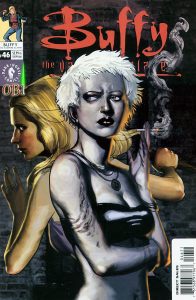
“Withdrawal” (Issue 46, June 2002)
For their swan song, Fassbender and Pascoe jump to Season 6 between “Doublemeat Palace” (6.12) and “Hell’s Bells” (6.16), and they nicely flesh out story points such as how Xander loves Anya yet fears marrying her, how Willow is trying to fight the temptation to use magic, and how Buffy is using Spike yet starting to show grudging appreciation. She even says “Thank you, Spike” at the end.
The villain is Velatti, a vampire from the authors’ illustrated novel “Creatures of Habit,” doing her “one last scare” over a whole issue. Perhaps I’ll appreciate her more when I get to my re-read of that book, but she’s rather generic here, doing a tame version of the villainous scheme of messing with the heroine’s friends and family before targeting the Slayer herself.
Taking over for Cliff Richards, the artist for Fassbender and Pascoe’s work up to this point, is Paul Lee. At first blush, I don’t like his work quite as much, as the art is stiffer, sparser and inkier. But it uses dark color choices effectively and I can easily tell who all the characters are.
3.5 stars
Click here for an index of all of John’s “Buffy” and “Angel” reviews.

